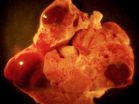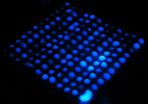(Press-News.org) DURHAM, NC – Duke University bioengineers have developed a new method for rapidly producing an almost unlimited variety of man-made DNA sequences.
These novel sequences of recombinant DNA are used to produce repetitive proteins to create new types of drugs and bioengineered tissues. Current methods for producing these DNA sequences are slow or not robust, the researchers said, which has hindered the development of these increasingly important new classes of protein-based polymers.
Researchers have already demonstrated that when a large protective macromolecule – known as a polymer – is attached to a protein, it greatly improves effectiveness and allows the protein to remain active in the bloodstream longer. There are many protein-polymer based medications in use today, such as human growth hormones, drugs to stimulate blood cell formation in cancer patients and anti-viral agents.
"This new technique should be very useful in making a practically unlimited number of these protein building blocks," said Ashutosh Chilkoti, Theo Pilkington Professor of Biomedical Engineering at Duke's Pratt School of Engineering. The results of the Duke team's experiment were published online in the journal Nature Materials. Graduate students Miriam Amiram and Felipe García Quiroz, working in Chilkoti's lab, were co-first authors of this paper.
"Depending on how complicated you want the polymer sequence to be, there are an infinite number of combinations you could make," Chilkoti said. "We haven't even begun to look at all the sequences that can be made or the unique properties they might have."
The researchers call the new process overlap-extension rolling circle amplification, and it is a modification of existing technologies. Because of this, they said that other laboratories would not need major investments in new equipment or materials.
"A very popular method for making tandem copies of DNA sequences involves inserting them iteratively into a bacterial plasmid," Amiram said. "After the vector has grown in size, the copies of the sequence are cut out using enzymes and the process is repeated to generate a larger polymer. It is a very time-consuming process.
"With this new method, you don't get just one product, but many," she said. "This should help us to make large libraries of proteins, which we can use to rapidly screen new combinations. This powerful strategy generates libraries of repetitive genes over a wide range of molecular weights in a 'one-pot' parallel format."
Chilkoti compared it to sausage-making. Instead of stuffing the casings one-by-one individually, the new tool can rapidly stuff and stitch together long strings of sausages.
"This could help remove one of the biggest stumbling blocks we face in producing these drugs," Chilkoti said. "You can't make the proteins without genes, which act as the software directing the protein's production. Instead of building each sequence individually, as is done now, we can literally make hundreds, each with subtle differences."
The researchers used the system to synthesize genes found in two classes of protein-polymers. In the first, they produced protein-polymer combinations for elastin, a ubiquitous protein found in connective tissue. The researchers term them "smart" protein-polymers because they can be controlled by heat.
In the second set of experiments, they rapidly synthesized novel glucagon-like peptide-1 (GLP-1) analogs to show variable pharmokinetic properties. GLP-1 is a hormone that acts to release insulin in the body.
INFORMATION:
The research was supported by the National Institutes of Health. The other member of the team from Duke was Daniel Callahan.
New method for rapidly producing protein-polymers
2011-01-26
ELSE PRESS RELEASES FROM THIS DATE:
3-D MRI helps kids with ACL tears -- surgery without harming the growth plate
2011-01-26
Surgery has not been an option in the past for children with ACL tears because of the possible damage to the growth plate that can cause serious problems later in life.
With this new technology, surgeons can actually see from one point to the other on either side of the knee, and can safely position the tunnels where they will place the new ligament.
John Xerogeanes, MD, chief of the Emory Sports Medicine Center, and colleagues in the laboratory of Allen R. Tannenbaum, PhD, professor in the Wallace H. Coulter Department of Biomedical Engineering at Georgia Tech and ...
Study: Tiger numbers could triple if large-scale landscapes are protected
2011-01-26
WASHINGTON, DC, January 25, 2011 – The tiger reserves of Asia could support more than 10,000 wild tigers – three times the current number – if they are managed as large-scale landscapes that allow for connectivity between core breeding sites, a new paper from some of the world's leading conservation scientists finds. The study, co-authored by World Wildlife Fund (WWF) scientists, is the first assessment of the political commitment made by all 13 tiger range countries at November's historic tiger summit to double the tiger population across Asia by 2022.
"A Landscape-Based ...
New method attacks bacterial infections on contact lenses
2011-01-26
VIDEO:
Jerry Nick, M.D., associate professor of medicine at National Jewish Health, discusses recent research on biofilms, bacterial infections and contact lenses.
Click here for more information.
Researchers at National Jewish Health and the University of Texas Southwestern Medical Center have discovered a new method to fight bacterial infections associated with contact lenses. The method may also have applications for bacterial infections associated with severe burns and ...
Study raises safety concerns about experimental cancer approach
2011-01-26
A study by researchers at Washington University School of Medicine in St. Louis has raised safety concerns about an investigational approach to treating cancer.
The strategy takes aim at a key signaling pathway, called Notch, involved in forming new blood vessels that feed tumor growth. When researchers targeted the Notch1 signaling pathway in mice, the animals developed vascular tumors, primarily in the liver, which led to massive hemorrhages that caused their death.
Their findings are reported online Jan. 25 in the Journal of Clinical Investigation and will appear ...
Caffeine energizes cells, boosting virus production for gene therapy applications
2011-01-26
New Rochelle, NY, January 25, 2011—Give caffeine to cells engineered to produce viruses used for gene therapy and the cells can generate 3- to 8-times more virus, according to a paper published in Human Gene Therapy, a peer-reviewed journal published by Mary Ann Liebert, Inc. (www.liebertpub.com). The paper is available free online at www.liebertpub.com/hum
This simple and inexpensive strategy for increasing lentivirus production was developed by Brian Ellis, Patrick Ryan Potts, and Matthew Porteus, University of Texas Southwestern Medical Center, Dallas. In their paper, ...
New lab-on-chip advance uses low-cost, disposable paper strips
2011-01-26
WEST LAFAYETTE, Ind. - Researchers have invented a technique that uses inexpensive paper to make "microfluidic" devices for rapid medical diagnostics and chemical analysis.
The innovation represents a way to enhance commercially available diagnostic devices that use paper-strip assays like those that test for diabetes and pregnancy.
"With current systems that use paper test strips you can measure things like pH or blood sugar, but you can't perform more complex chemical assays," said Babak Ziaie, a Purdue University professor of electrical and computer engineering and ...
Armchair nanoribbons made into spintronic device
2011-01-26
Washington, D.C. (January 25, 2011) -- In a development that may revolutionize handheld electronics, flat-panel displays, touch panels, electronic ink, and solar cells, as well as drastically reduce their manufacturing costs, physicists in Iran have created a spintronic device based on "armchair" graphene nanoribbons. Spintronic devices are being pursued by the semiconductor and electronics industries because they promise to be smaller, more versatile, and much faster than today's electronics.
As described in the American Institute of Physics journal Applied Physics Letters, ...
Nanotech milling produces dramatic increase in thermoelectric performance of bulk semiconductor
2011-01-26
CHESTNUT HILL, MA (1/25/11) -- Researchers from Boston College, MIT, Clemson and Virginia have used nanotechnology to achieve a 60-90 percent increase in the thermoelectric figure of merit of p-type half-Heusler, a common bulk semiconductor compound, the team reported in the American Chemical Society journal Nano Letters.
The dramatic increase in the figure of merit, used to measure a material's relative thermoelectric performance, could pave the way for a new generation of products – from car exhaust systems and power plants to solar power technology – that that runs ...
Graphene and 'spintronics' combo looks promising
2011-01-26
Washington, D.C. (January 25, 2011) -- A team of physicists has taken a big step toward the development of useful graphene spintronic devices. The physicists, from the City University of Hong Kong and the University of Science and Technology of China, present their findings in the American Institute of Physics' Applied Physics Letters.
Graphene, a two-dimensional crystalline form of carbon, is being touted as a sort of "Holy Grail" of materials. It boasts properties such as a breaking strength 200 times greater than steel and, of great interest to the semiconductor and ...
NASA infrared data sees birth of 10th tropical depression in Southern Indian Ocean near Australian coast
2011-01-26
NASA's Aqua satellite captured an infrared image of the very cold clouds that house powerful thunderstorms within the Southern Indian Ocean's newest tropical depression, number 10S. The depression quickly strengthened into a tropical storm and continues to affect the northern coast of Western Australia.
When Aqua passed over the Tropical Storm 10S on January 25 at 05:53 UTC (12:53 a.m. EST), the Atmospheric Infrared Sounder (AIRS) instrument captured an infrared image of the storm's clouds. The image showed that most of the coldest cloud tops (-63 Fahrenheit/-52 Celsius) ...




